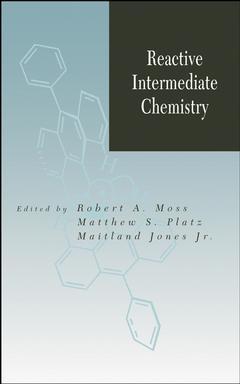Description
Reactive Intermediate Chemistry
Coordinators: Moss Robert A., Platz Matthew S., Jones Maitland
Language: English
Subject for Reactive Intermediate Chemistry:
Keywords
mechanistic; central; modern; quantitative; reactive; coverage; comprehensive; chemistry; intermediates; integral; portion; synthetic; significant; view; molecular; biological; uptodate; intermediate chemistry; guide; area; fundamental
1084 p. · 16.1x24.4 cm · Hardback
Description
/li>Contents
/li>Biography
/li>
Reactive Intermediate Chemistry provides a deeper understanding of contemporary physical organic chemistry, and will assist chemists in the design of new reactions for the efficient synthesis of pharmaceuticals, fine chemicals, and agricultural products. Among its features, this authoritative volume is:
- Edited and authored by world-renowned leaders in physical organic chemistry.
- Ideal for use as a primary or supplemental graduate textbook for courses in mechanistic organic chemistry or physical chemistry.
- Enhanced by supplemental reading lists and summary overviews in each chapter.
PART 1: REACTIVE INTERMEDIATES.
1. Carbocations (R.A. McClelland).
2. Crossing the Borderline Between SN1 and SN2 Nucleophilic Substitution at Aliphatic Carbon(T.L. Amyes, et al.).
3. Carbanions (S. Gronert).
4. Radicals (M. Newcomb).
5. Non-Kekul Molecules as Reactive Intermediates (J.A. Berson).
6. Organic Radical Ions (H.D. Roth).
7. Singlet Carbenes (M. Jones Jr. and R.A. Moss).
8. Stable Singlet Carbenes (G. Bertrand).
9. Triplet Carbenes (H. Tomioka).
10. Atomic Carbon (P.B. Shevlin).
11. Nitrenes (M.S. Platz).
12. Synthetic Carbene and Nitrene Chemistry (M.P. Doyle).
13. Nitrenium Ions (D.E. Falvey).
14. Silylenes (W. Ando and N. Tokitoh).
15. Strained Hydrocarbons: Structures, Stability, and Reactivity (K.B. Wiberg).
16. Arynes (M. Winkler, et al.).
PART 2: METHODS AND TEMPORAL REGIMES.
17. Matrix Isolation (T. Bally).
18. Nanosecond Laser Flash Photolysis: A Tool for Physica l Organic Chemistry (J.C. Scaiano).
19. The Picosecond Realm (E. Hilinski).
20. Reactions on the Femtosecond Time Scale (J.E. Baldwin).
21. Potential Energy Surfaces and Reaction Dynamics (B.K. Carpenter).
22. The Partnership Between Electronic Structure Calculations and Experiments in the Study of Reactive Intermediates (W.T. Borden).
Index.
Matthew S. Platz was born in New York City and graduated from the State University of NY at Albany ( B.Sc. in Chemistry and Mathematics) in 1973 and obtained his Ph.D. in Chemistry studying with Professor Jerome Berson in 1976. After a postdoctoral stint with Professor Gerhard Closs, Platz joined the faculty of The Ohio State University in 1978 where he has spent his entire independent career. Platz served as chair of the OSU Chemistry Department from 1994-1999, was the Melvin S. Newman Professor (1994-2001), and was named Distinguished University Professor in 2001. Platz has been a Sloan Fellow, a Camille and Henry Dreyfus Teacher-Scholar, and a Cope Scholar of the American Chemical Society. He has over 200 scientific publications and holds over a dozen patents.
Maitland Jones, Jr. turned to chemistry only after the invention of the curveball by his peers made it clear that he would never be a major league centerfielder. He received his B.S. degree from Yale College and his M. S. and Ph. D. degrees from Yale University, where he studied with William von E. Doering. After a postdoctoral year with Jerry Berson at Wisconsin he came to Princeton in 1964 as an Instructor. He has been there ever since, and is now David B. Jones Professor of Chemistry. He has been a visiting professor at Columbia and Harvard
These books may interest you

Carbenes nitrenes and arynes 116.04 €



